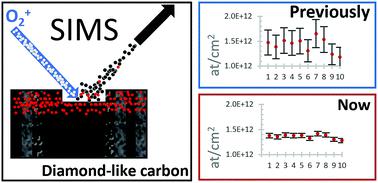当前位置:
X-MOL 学术
›
J. Anal. At. Spectrom.
›
论文详情
Our official English website, www.x-mol.net, welcomes your
feedback! (Note: you will need to create a separate account there.)
Quantifying low fluence ion implants in diamond-like carbon film by secondary ion mass spectrometry by understanding matrix effects
Journal of Analytical Atomic Spectrometry ( IF 3.1 ) Pub Date : 2020-12-7 , DOI: 10.1039/d0ja00375a Amy J. G. Jurewicz 1, 2, 3, 4 , Chad T. Olinger 4, 5, 6, 7 , Donald S. Burnett 4, 8, 9, 10 , Yunbin Guan 4, 8, 9, 10 , Richard Hervig 1, 4, 11, 12 , Karen D. Rieck 4, 13, 14 , Dorothy S. Woolum 4, 15, 16, 17
Journal of Analytical Atomic Spectrometry ( IF 3.1 ) Pub Date : 2020-12-7 , DOI: 10.1039/d0ja00375a Amy J. G. Jurewicz 1, 2, 3, 4 , Chad T. Olinger 4, 5, 6, 7 , Donald S. Burnett 4, 8, 9, 10 , Yunbin Guan 4, 8, 9, 10 , Richard Hervig 1, 4, 11, 12 , Karen D. Rieck 4, 13, 14 , Dorothy S. Woolum 4, 15, 16, 17
Affiliation

|
Minor and trace elements in diamond-like carbon (DLC) are difficult to quantify using SIMS analysis because minor elemental and structural variations can result in major matrix effects even across individual, cm-sized samples. While this material is most commonly used for tribological coatings where minor element composition is not of critical importance, it is being increasingly used in electronic devices. However, it is a unique application that spurred this work: anhydrous, tetrahedrally-coordinated DLC (ta-C) was used as a solar wind (SW) collector material in the Genesis solar-wind sample return mission (NASA Discovery 5). So, for ∼15 years, we have been working on attaining accurate and precise measurement of minor and trace elements in the Genesis DLC using SIMS to achieve our mission goals. Specifically, we have learned to deal with relevant matrix effects in our samples, ion implants into ta-C. Our unknown element for quantification is SW Mg, a low-dose (1.67 × 1012 at cm−2; ∼6 μg g−1 24Mg), low-energy (∼24 keV average energy) implant; our standard is a high-dose (∼1 × 1014 at cm−2 of both 25Mg, 26Mg) 75 keV laboratory implant for which the absolute 26Mg/25Mg ratio had been measured to account for variable instrumental mass fractionation. Analyses were performed using O2+ primary ions having both a low impact energy and a current density of ∼2 × 1014 ions per cm2. Although our unknown was solar wind, the method is applicable to many situations where minor elements in DLC need to be quantified. Recommendations are presented for modifying this data-reduction technique for other SIMS conditions.
中文翻译:

通过了解基质效应,通过二次离子质谱法对类金刚石碳膜中的低通量离子注入进行定量
使用SIMS分析很难量化类金刚石碳(DLC)中的微量和痕量元素,因为微小的元素和结构变化甚至在单个,厘米大小的样品中也可能导致主要的基质效应。虽然这种材料最常用于微量元素组成并不十分重要的摩擦涂层,但它正越来越多地用于电子设备中。但是,这是一项独特的应用,刺激了这项工作:在Genesis太阳风样品返回任务(NASA Discovery 5)中,无水,四面体配位DLC(ta-C)被用作太阳风(SW)收集器材料。因此,大约15年以来,我们一直在努力使用SIMS对Genesis DLC中的微量和痕量元素进行准确,精确的测量,以实现我们的任务目标。特别,我们已经学会了如何处理样品中的相关基质效应,即将离子注入ta-C。我们未知的定量元素是SW Mg,一种低剂量(1.67×1012在cm -2处;约6μgg -1 24 Mg)低能量(约24 keV平均能量)植入物; 我们的标准是高剂量(两种25 Mg, 26 Mg的cm -2处均为〜1×10 14)的75 keV实验室植入物,已测量出其绝对26 Mg / 25 Mg的比例以说明可变的仪器质量分数。使用了O进行分析2 +同时具有低的冲击能量和〜2×10的电流密度的初级离子14离子每cm 2。尽管我们未知的是太阳风,但该方法适用于许多需要对DLC中的微量元素进行量化的情况。提出了针对其他SIMS条件修改此数据缩减技术的建议。
更新日期:2020-12-09
中文翻译:

通过了解基质效应,通过二次离子质谱法对类金刚石碳膜中的低通量离子注入进行定量
使用SIMS分析很难量化类金刚石碳(DLC)中的微量和痕量元素,因为微小的元素和结构变化甚至在单个,厘米大小的样品中也可能导致主要的基质效应。虽然这种材料最常用于微量元素组成并不十分重要的摩擦涂层,但它正越来越多地用于电子设备中。但是,这是一项独特的应用,刺激了这项工作:在Genesis太阳风样品返回任务(NASA Discovery 5)中,无水,四面体配位DLC(ta-C)被用作太阳风(SW)收集器材料。因此,大约15年以来,我们一直在努力使用SIMS对Genesis DLC中的微量和痕量元素进行准确,精确的测量,以实现我们的任务目标。特别,我们已经学会了如何处理样品中的相关基质效应,即将离子注入ta-C。我们未知的定量元素是SW Mg,一种低剂量(1.67×1012在cm -2处;约6μgg -1 24 Mg)低能量(约24 keV平均能量)植入物; 我们的标准是高剂量(两种25 Mg, 26 Mg的cm -2处均为〜1×10 14)的75 keV实验室植入物,已测量出其绝对26 Mg / 25 Mg的比例以说明可变的仪器质量分数。使用了O进行分析2 +同时具有低的冲击能量和〜2×10的电流密度的初级离子14离子每cm 2。尽管我们未知的是太阳风,但该方法适用于许多需要对DLC中的微量元素进行量化的情况。提出了针对其他SIMS条件修改此数据缩减技术的建议。











































 京公网安备 11010802027423号
京公网安备 11010802027423号